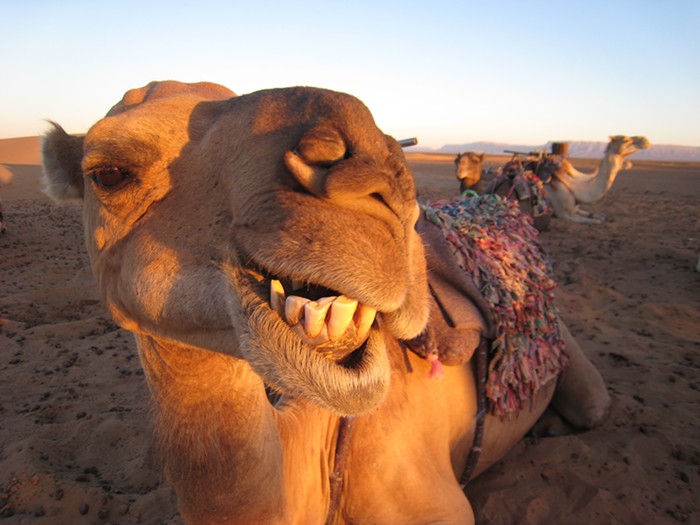OREGON BIOLOGIST George Poinar Jr. is bugged by Jurassic Park. But he has a right to be. His science inspired the books and films.
It was Poinar's work in the 1980s that first hinted at the prospect of using prehistoric DNA preserved in amber to restore extinct creatures to life. That work caught the eye of Jurassic Park author Michael Crichton—and the rest is sci-fi history. The scientific history, however, is something else entirely.
Arguably the world's leading expert on amber paleontology, Poinar's vision of the past is a vicious, self-devouring circle of life. A world where insects reign supreme, where dinosaurs have psychedelic trips, and where disease ravages all—ultimately delivering the knock-out punch to the dinosaurs that even a cataclysmic meteorite could not.
But this isn't what he's known for.
For much of his career, the Jurassic Park franchise has buzzed around Poinar like so many of the ancient pests he investigates. With Jurassic World opening in theaters this week, the 79-year-old scientist once again finds himself fielding calls about DNA research he's largely abandoned.
He doesn't mind. But he's troubled that amid the CG dinosaurs crashing through multiplexes, the real monsters of prehistory—the bugs, blights, and pathogens—are overlooked. If Poinar's work has shown anything, it's that those little things not only matter, but the world they reveal is more brutal and bizarre than even Crichton or Steven Spielberg could imagine.
Scene: Middle Cretaceous Period (roughly 100 million years ago); Site: What's now Myanmar:
The herd is being devastated. The semi-bipedal, plant-eating ornithopod dinosaurs (similar to the flock of duck-billed Parasaurolophuses seen at the start of Jurassic Park) are sick. From the back end of their alimentary canals, they defecate bloody stool. The piles of crimson-colored crap quickly swarm with flies, beetles, and cockroaches. From their front ends, the animals hock bloody phlegm filled with wriggling roundworms. Several finally succumb to the tiny predators—and that's when the big predators arrive. These meat-eating theropods (such as the T. rex) feed on the plant eaters' diseased flesh, inadvertently turning their own bodies into breeding grounds for the parasites.
This piece of speculative prehistory—paraphrased from Poinar's book What Bugged the Dinosaurs?—isn't hyperbole on my part. Poinar's writing is filled with equally gruesome, carefully researched speculation—dinosaurs sucked dry by vampiric insects; dinosaurs swarming with fleas and lice under their feathers; dinosaurs stumbling around half-blind from the parasitic worms squirming in their eyes. From descriptions like these, I'd imagined Poinar as a morbid, nerdy teenager trapped in a septuagenarian's body. Instead I found a man as gracious as his subjects are repulsive.
I met up with Poinar on a balmy spring day on Oregon State University's Corvallis campus, where he's professor emeritus in the school's biology department.
In the tradition of other biologists and naturalists of his generation, including Sir David Attenborough and E.O. Wilson (who Poinar vaguely resembles, in a slightly portly way), Poinar's work is all about the big ecological picture.
"A lot of people are specialized today," explains Poinar. "They don't know—or they're too busy to look at—how all these pieces fit together."
Poinar isn't so shortsighted. His circuitous career path took him from ornithology to botany to entomology to pathology, then back to entomology. Poinar's major skill set is decidedly old school, revolving around morphology—roughly the deciphering of the biological world based on patterns—a dying expertise now largely the province of older scientists.
But don't get the wrong idea: Poinar hasn't spent his life cloistered in a lab. His understanding of ancient life forms comes from examining living ones—a quest that's entailed, among other exploits, using his bare skin as bait to capture disease-carrying flies in West Africa.
"It was scary, the diseases there," says Poinar. "Anything that bit you, you wondered, 'What's that carrying?'"
Yet Poinar isn't reckless. He's meticulous.
A classically trained musician, Poinar credits his father—a Bach scholar who kept him at the piano and violin for hours every day—for his attention to detail. But his mother arguably had the more profound effect on the budding biologist. It was her copy of naturalist Willy Ley's 1951 book Dragons in Amber and its cover art of two insects trapped in the fossilized material that intrigued Poinar.
"In the back of my mind," he remembers, "I thought 'Gee, I'd really like to find a piece of amber like that.'"
In 1973 he got his chance. Poinar, then at UC Berkeley's entomology department, got a request from the paleontology department. Could he identify what could be either plant fibers or worms (nobody knew which) in Mexican amber? Poinar jumped at the opportunity.
It turned out they were worms—or more precisely, nematodes. Further study showed entire colonies of the tiny critters, suspended in mid-movement, frozen in time. The sight reminded Poinar of Pompeii.
Scene: Tertiary Period (roughly 15 to 45 million years ago); Site: What's now the Dominican Republic:
The dinosaurs are long gone. Our worker bee could care less. She's whizzing through a dense tropical forest in search of tree sap to help build her hive. Then something goes terribly wrong... she's trapped by the sap of a towering algarrobo tree.
The viscous resin—part of the tree's defense system—engulfs her. Then the translucent goo's chemical weapons go to work. Sugars from the sap suck the water out of her as chemicals, called terpenoids, penetrate down to her cellular and subcellular levels, embalming her. Sunlight and oxygen seal the deal, strengthening the resin's molecular bonds, hardening the material until it breaks away from the tree and is buried.
That scene—paraphrased from Poinar's The Amber Forest—is essentially how amber is made, though the exact chemical details remain unknown. What isn't mysterious is that amber's incredibly good at preserving cellular tissue. To hear Poinar describe specimens in amber is like listening to a man who's had a spiritual revelation.
"It's a mystical experience, truly breathtaking," says Poinar. "It takes you to another domain, transporting you into a past world. It puts everything into perspective—the things that came before us, and what's likely to come after we leave. That's the kind of perspective that most people don't get."
Among his many revelatory amber encounters, Poinar has discovered the oldest known bee and mushroom. He's identified the oldest evidence of sex in flowering plants, and lent support to research suggesting flowering plants went through a major extinction before producing the forms we know today.
Most recently, Poinar made headlines with his discovery of ergot fungus found in Cretaceous grass. During the Middle Ages, ergot-infected rye was sometimes accidentally made into poisoned bread. The result was St. Anthony's Fire, an occasionally lethal intoxication replete with gangrenous limbs and excruciating convulsions. Oh yeah, and while all that was happening? The victims were probably tripping balls. Ergot contains lysergic acid diethylamide—better known as LSD. Poinar's discovery raised the prospect that dinosaurs—potentially even sauropods similar to the massive Apatosaurus—might have tripped. (Like ergot's "bewitched" victims in the Middle Ages, or boomers who ate the "brown acid" at Woodstock, they probably didn't enjoy the experience.)
The study of ancient diseases—plant and animal—is arguably Poinar's most important contribution to science. Beginning with those nematodes in 1973, which Poinar discovered were suffering from a fungal infection, Poinar's discoveries have included locating the first known insect-borne disease, a discovery he shares with his wife, Roberta, with whom he's written several papers and books. Later, Poinar uncovered other ancient insect-transmitted pathogens, including the likely ancestors of malaria and Lyme disease. The latter discovery—which is spread by infected ticks—involved finding, among thousands of fossils, tick larvae about the size of poppy seeds.
The dinosaurs, Poinar surmises, were tormented by diseases and the critters that spread them, leading the naturalist to the conclusion that it was disease, not the meteorite that produced the Chicxulub crater, that did the dinosaurs in—though he concedes the fiery ball of doom certainly helped.
What all this adds up to is an image of dinosaurs as something more than blockbuster monsters. Poinar's vision is one of animals in an ecosystem—an ecosystem where insects and diseases ruled. (That's something, he says, the planet's current purported rulers would do well to keep in mind.) As for Jurassic World and its likely sequels, Poinar is resigned to his fate: Jurassic Park has entrapped and preserved his legacy. He just hopes some of the rest of his work will be remembered too.
"I wasn't in the movie or anything!" laughs Poinar. "And after I'm gone, that's probably the only thing anyone will remember about me, which is funny."



















